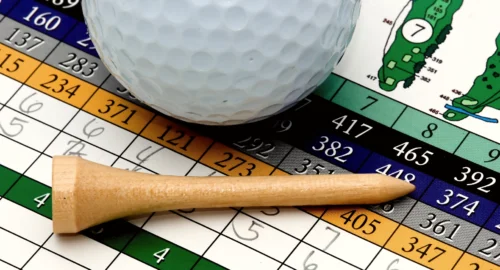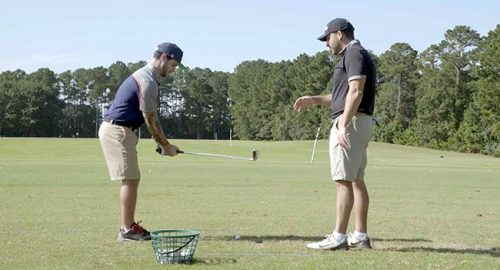
If you’re new to golf, you might have wondered, how does scoring work?
What is the difference between stroke play vs. match play?
Do mulligans count toward your score?
How do penalty strokes work?
These are all great questions and ones you’ll definitely need answered if you want to start playing golf. Golf scoring is a little bit complex, especially when you abide by the official rules of golf. Keep reading to learn the basics, common rules, different types of games, handicapping, and other best practices in golf.
Overview of Golf Scoring
Before getting into the basics of golf scoring, let’s first establish what handicaps are to better understand the average golfer. Handicaps are part of what makes golf such a great sport, as you can compete with players of all skill levels on any course.
Understanding Golf Handicaps
Think of a handicap like your scoring potential – it represents a slightly lower number than your average score per round. The handicapping system essentially makes it easy to understand the range of scores you should shoot during a given round. To determine, players usually enter the scores into the GHIN system after the round to determine their handicap.
According to the USGA, more than 3M people have an established handicap. The average male handicap is about 14, while the average female handicap is about 28.
Beginner handicappers are typically 20+ for men and average a score in the 90s or 100s. Mid level handicaps shoot in the 80s or 90s, while lower handicap golfers shoot in the 80s or 70s.
For example, if you’re a 10 handicap, you’ll typically shoot 10-15 over par. On most golf courses that’d be a score from 82-87 and might be lower or higher based on the golf course difficulty.
Scoring (Stroke vs. Match Play)
The most common way to play golf is a stroke play method, and is the one used by the PGA Tour for most events. This scoring system is pretty straightforward – each golfer adds up how many strokes it took them to play the hole. They log this on a scorecard and add their score up after 18 holes for a total score.
In tournaments (such as a scramble or club championship) there are two types of stroke play formats; gross and net scoring. Gross scoring does not involve your handicap and is preferred by more advanced golfers.
Net scoring, however, takes your handicap into account for scoring. For example, if you’re a 10-handicap golfer and shoot a gross score of 80, your net score is 70.
Your score – your handicap = net score
Match play is a different golf format where you team up. This can be when two golfers play head to head and only play versus one other golfer. Or, your team competes against another team. In this type of scoring, a player or team can only lose by one shot – regardless of the stroke differential.
You can find several match play challenges on our YouTube channel, like this one! Check it out.
Now, in match play, if you make a four and your competitor makes an eight on the hole, you win the hole one up. Essentially, each “team” wins each hole, and at the end of the round whoever won the most holes overall wins the match. This scoring method is a favorite among players and the format used for the Ryder Cup and Presidents Cup.
Other common games and scoring methods include:
- Wolf
- Skins
- Stableford
There are many other more formats for golf scoring, and you look forward to another blog post on these more niche methods in the future!
Mulligans
A common golf term is the “mulligan,” which is essentially a re-do of the previous shot. For example, let’s say you hit a terrible shot on the first tee. A fellow player might throw you a ball and say, “Take a mulligan” or “Hit a breakfast ball” (the first shot of the day) as a redo.
You can then hit again and play the better of the two shots without penalty. This isn’t allowed in competition but very common among everyday golfers.
Golf Rules
There are a lot of rules in golf and it’s easy to get overwhelmed as a new player. But if you want to take the game seriously and become an avid golfer, you’ll need to learn how different rules impact scoring.
Here are some of the most common scenarios and how they relate to total score.
- Out of Bounds (OB): If you hit a golf ball out of bounds, which is typically defined by white lines or external fencing/walls on the course, there is a two-shot penalty. When you hit a drive out of bounds, you’ll re-tee and hit your third shot.
- Penalty Areas: If you hit a golf ball in a penalty area (previously defined as hazards), such as a lake, there is a one-shot penalty. You’ll drop behind the penalty area or laterally and add one stroke to your total score of the hole.
- Lost Ball: If you lose a golf ball and can’t find it after three minutes of searching, you’ll need to play again from the previous spot. This is a two-shot penalty – referred to as stroke and distance – as you’ll add a stroke and replay from the previous spot.
- Unplayable Lies: If your golf ball ends up in a tough spot where you can’t make a swing – such as next to a cactus or next to a tree – you can take an unplayable lie. You’re allowed to drop the ball a few different ways as long as it’s not closer to the hole. You’ll then add one more shot to your score for the hole.
There are a lot of other rules scenarios, but these are some of the most common. If you ever have scoring questions, ask a more experienced golfer to avoid any rules issues.

Entering Scores
It’s common for one person to keep score for the entire group during the round. This individual usually writes down each player’s score on the scorecard that is provided by the golf course.
In golf tournaments, the scorer (known as the marker) will need to sign as well as the player to confirm the scores. Sometimes you’ll enter scores into an app like Golf Genius or Blue Golf as well, so everyone can see the scores via a live leaderboard.
Once a round is complete, it’s recommended to enter your score into the GHIN system. This will help you keep your handicap up to date and track your progress over time.
You’re Ready to Golf!
Scoring is a little complex if you’re just getting started, and not something we recommend focusing on too much in the beginning. Instead, spend time getting to know your golf swing, basic short game techniques, rules, and etiquette of a golf course.
Once you develop a consistent practice routine, it’s time to take your game to the golf course, typically at an executive-level course. Then once you’re ready, move to a championship course and start taking scoring more seriously.
If you want to learn how to shoot lower scores and better your handicap, make sure to check out Scratch Club. This proven system will help you learn the five fundamentals of the game to play better golf faster than ever. Or, if a specific issue is holding you back – like slicing the golf ball – check out different training programs.

